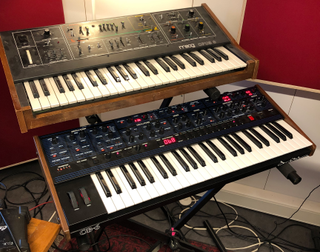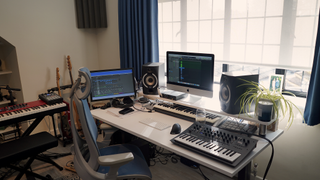Pablo Nouvelle & Kinnship: "There’s something about physical knobs and buttons that leaves space for creativity and improvisation, compared to menu-diving and mouse clicking"
The duo go deep into the studio gear and and production techniques behind their new collaborative LP Stones & Geysers

Fabio Friedli’s stage name, Pablo Nouvelle, hints at a love for French cinema, specifically the nouvelle vague of the late ‘50s. It’s fitting, then, that his music shares a cinematic and existential bent with the French New Wave, shrouding propulsive electronics and stately piano chords in atmospheric synths that ripple with emotion.
When Pablo found a kindred spirit in English multi-instrumentalist Kinnship, who writes and records similarly soul-stirring electronica, the pair felt that their talents were naturally suited to a collaboration. The result is Stones & Geysers, a 10-track album of "electronic folk" that gently blends gently articulated piano, guitar and vocals with widescreen electronics. We spoke with the pair about the inspirations behind their latest release, hearing about the synths, software and creative techniques that underpin Stones & Geysers.
How would you describe the sound of your forthcoming collaboration to a new listener?
Kinnship: “Melodic, electronic folk… it’s really an electronic record, full of synthesizers and drum patterns, but there’s some more natural instrumentation such as upright piano and strings, and we both agree that it feels like a folk record somehow. Steeped in nature and hopefully carries the essence of collaboration!”
What compelled you to collaborate on this project in the first place?
K: “We had worked together on a couple of tracks for our respective solo projects, and we found working together incredibly easy, and ideas came very quickly, so it was really a desire to do more of that, helped by the fact that Pablo was living in London at the time. After a couple of sessions it became clear that we were on the way to making a body of work.”

What has inspired the creative process for your latest release?
Get the MusicRadar Newsletter
Want all the hottest music and gear news, reviews, deals, features and more, direct to your inbox? Sign up here.
K: “In a word, nature! The album lyrically is based on the concept of describing spiritual, emotional or unseen things in physical, day-to-day objects and ideas. It’s personally something I tend to often do in my lyrics, and with this album I tried to immerse myself in the imagery of nature, and I think it grew the more Pablo and I spoke about our mutual love for the outdoors.”
What’s the most important bit of kit in your studio, and why is it important to you?
K: “I think it has to be the Korg Minilogue XD - we used the original Minilogue a lot for this record, as Pablo had one in his studio, and I found it incredibly fun and intuitive to use. So much so that I bought the new XD model and I can already tell that it will be an indispensable piece of kit in my songwriting and producing.
Don’t do everything in the box. Record an acoustic element. Even if it’s only tapping on the table with your fingertip
“There’s something about physical knobs and buttons that leaves space for creativity and improvisation, compared to menu-diving and mouse clicking.”
Pablo Nouvelle: “The honest, unromantic truth: my laptop. I wouldn’t get very far without it. As much as I love my upright Yamaha Piano and my OB-6 synthesizer, most of the time my fingers lay on the computer's keyboard (instead of the piano's keys) chopping up samples and arranging songs.”

Tell us a little about the rest of your studio set-up.
K: “I have quite a simple set up, and probably in need of an update! I use Logic Pro X on an iMac, and I have an old Focusrite Saffire Pro 24, which I often record into using a Neumann TLM-102.”
“The Minilogue XD sits on my right, and the Nord Electro 6HP sits on my left. The Nord is a wonderful keyboard - incredible sounds and action with some great effects that inspires more creativity. Otherwise, I have a few guitars, a bass, a ukelele, a violin, and various shakers collected from around the world.”
P: “I’m working on Cubase on a Macbook Pro from 2016 which will be soon replaced. Using an old RME interface and listening on BM5 Dynaudio speakers with a sub. That’s the boring essentials but they are SO important. You can’t paint a picture with your eyes closed. I know my speakers better than my own trouser pockets. (Most of them have holes and I keep on losing all my stuff anyways...)”
I know my speakers better than my own trouser pockets. (Most of them have holes and I keep on losing all my stuff anyways...)
“Up to the fun stuff: I love a good software plugin like Diva, Serum or Keyscape and the Soundtoys effects are great. So is Valhalla. But even better is hardware gear: My main instrument is an upright Yamaha piano from the 80s with a thick felt to cut off the highs. Got myself a new Mellotron lately which is going through an original RE-501 Tape Delay.
“Best in class: OB-6 -by Dave Smith’s Sequential - such a beautiful instrument! And from Roland’s Boutique line JU-06a, the little remake of the Junos.”

What are your most essential plugins?
K: “I tend to use stock plugins most of the time, as I find it forces me to affect and mangle a sound until it sounds less, well, like a stock plugin...! I use the Pitch Shifter and Tape Delay a lot as it adds some nice artefacts, and the different modelled compressors are great. Otherwise, I use XLN Audio’s Addictive Keys and iZotope Vinyl a lot.”
P: “An insanely strong plug-in to breathe life into a recorded track is the RC-20 Retro Color.”
What’s on your wishlist studio-wise?
K: “Probably some plugins! RC-20 Retro Colour is one that I’m sure Pablo can vouch for, as I believe we used that a lot on the record to add some character to certain instruments.”
P: “Go on and get it then, it costs nothing! I almost bought a Mono/Poly by Korg last week but a guy in the shop bought the last one just in front of my nose. I might get the V8 Collection by Arturia and the FX Collection 2 once I got a laptop strong enough to run it. The new Take 5 by Sequential looks amazing too. And one day I might invest in a new Nord Piano for my live set up.”

What would you like to see developed in terms of studio technology, and why?
K: “That’s a good question...! I think generally I’m always amazed at the developments in studio technology, but if I had to choose, I’d like to see the world of home monitoring made more accessible, in the sense that I find it difficult to make one’s home studio truly acoustically treated, without spending a lot of money.
If I arrive at version 27, I’ll most likely never release it. My best tunes are the most straightforward ones
P: “I would vote for a wireless world. No more power cables and especially no audio cable mess in live situations. Wouldn’t that be great.”

When you’re starting to work on a track, what elements do you start with?
K: “It often changes, but most of the time I will have an idea in my head of a drum pattern or a synth line. So I’ll start finding sounds, and when I land on the right thing, all of the other instruments start to fall into place nicely. The lyrics tend to come soon after that, if I haven’t already got a concept written down. The mood of the instrumental always dictates the lyrical content.”
P: “I often start with a reference to find inspiration. Once I know where I want to take a musical idea I soon start building drums out of chopped up samples. From there on it’s the song dictating where it wants to go.”
Conversely, how do you know when a track’s finished?
K: “Usually when I’m sick of it, or lose objectivity over it! Sometimes it just sounds right and I’ll call it a day, but most of the time I’m trying to add elements or even take away what’s unnecessary, and that process can take weeks or months, even. I’m not normally in a rush to finish a track, as I know that a song tends to flourish when it’s not forced.”
P: “I, on the other hand, try not to touch a song too much after once it’s done. If I arrive at version 27, I’ll most likely never release it. My best tunes are the most straightforward ones.”

Do you have any particular production tricks you can share with our readers?
K: “I’m enjoying playing with mid-side processing at the moment, adding weird distortion or effects to the side channels, and keeping the middle clean, for example. Also using an auto-filter guitar pedal on drum sounds can often create some strange effects.”
P: “Don’t do everything in the box. Record an acoustic element. Even if it’s only tapping on the table with your fingertip. Your mum might call for dinner at that very moment adding the needed texture to your tune to make it special. I love to record very quietly and push it afterwards with volume and compression. It creates an intimacy.”
How does your collaborative process work - is Kinnship writing to material that you send over, Pablo, or vice versa?
K: “For the album, we wrote all of the songs together in the studio, so it would be a real interaction between us - I would create some synth sounds or play something on the piano, and Pablo would start adding beats and other production elements. It was quite symbiotic - we would both be working on our independent ideas, but they would come together without stepping on each other’s toes.”
Are you planning any live shows in support of the release?
K: “Unfortunately due to Covid and being in different countries it’s been difficult to set up some shows around the release, but I am playing a mini UK tour in London, Manchester and Leeds in November where I’ll play one or two of the songs.”
P: “I’ll play some solo shows here and there in Switzerland but I'm looking forward to getting back on tour with my band next year.”
What other projects do you have coming up?
K: “There’s an EP I’ve produced for an artist from my Kinnship Presents: A Thousand Fibres project, and shortly after that there’ll be some new solo material from me.”
P: “Working on a lot of new stuff but for now the focus lies on the album release.”
Pablo Nouvelle & Kinnship’s Stones & Geysers is out 5th November on all platforms.



I'm MusicRadar's Tech Editor, working across everything from product news and gear-focused features to artist interviews and tech tutorials. I love electronic music and I'm perpetually fascinated by the tools we use to make it. When I'm not behind my laptop keyboard, you'll probably find me behind a MIDI keyboard, carefully crafting the beginnings of another project that I'll ultimately abandon to the creative graveyard that is my overstuffed hard drive.

“My love letter to a vanished era that shaped not just my career but my identity”: Mark Ronson’s new memoir lifts the lid on his DJing career in '90s New York

“I'm always starting up sessions and not finishing them, but I don't see that as unproductive”: Virtuosic UK producer Djrum talks creativity and making Frekm Pt.2









![Chris Hayes [left] wears a purple checked shirt and plays his 1957 Stratocaster in the studio; Michael J. Fox tears it up onstage as Marty McFly in the 1985 blockbuster Back To The Future.](https://cdn.mos.cms.futurecdn.net/nWZUSbFAwA6EqQdruLmXXh-840-80.jpg)